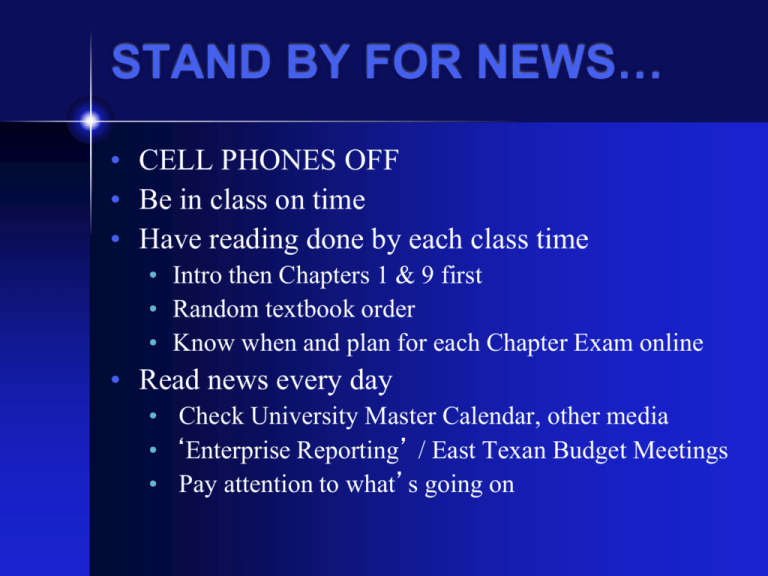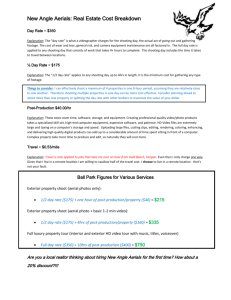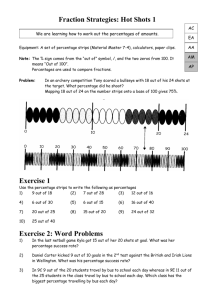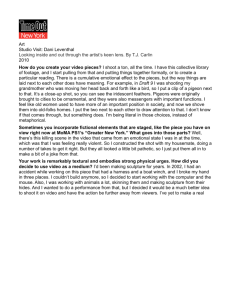Week 1 course PowerPoint
advertisement

STAND BY FOR NEWS… • CELL PHONES OFF • Be in class on time • Have reading done by each class time • Intro then Chapters 1 & 9 first • Random textbook order • Know when and plan for each Chapter Exam online • Read news every day • Check University Master Calendar, other media • ‘Enterprise Reporting’ / East Texan Budget Meetings • Pay attention to what’s going on Getting Started • Read the syllabus and review the outline • Start on training immediately • Have not completed RTV 322? You have extra work this week and next. • Everyone—sign up TODAY for shooting training • Before going—watch video & pass quiz • See production requirements • Spend first weeks assuring skills • Attend first Practicum meeting Story shooting (see link) • 1. You must shoot and edit sequences. If you are not certain you understand the concept, come get training. • Your projects must show clear indication of frequent sequencing, and have no pop cuts and/or jump cuts. • Good pacing -- no fewer than 3-4 shots per ten seconds of story content • Must have pad shot(s) as assigned #2 ‘must do’ • You may not use a zoom or pan shot, except in rare occasions for follow shots. In this case the zoom or pan must be ‘invisible.’ You must fade in and out, but have only cuts inside the story as transitions. #3 ‘must do’ • You may not have any ‘hand-held’ / shaky camera shots. If you submit a story with any ‘non broadcast quality’ shots, the submission will be rejected. #4 ‘must do’ • You must take and use a camera-mounted light each time. B-roll may be lit with available light—but MUST BE good light on the subject. • Every interview must have the cameramounted light turned on, or other clear indication of an acceptable key light on the subject. #5 ‘must do’ • You must take and use a lavaliere mic for every interview. To start the interview, you must start the camera recording, then have the subject say and spell his / her name. • You must ask each interview subject a minimum of five questions and must end with a question that says essentially ‘what else about this should the audience know?’ • Training interviews will be 10+ questions. #5 continued… • Your produced foreground audio must be throughout at ‘zero’ and your audio mix must be broadcast quality. • Make sure you capture good audio • Make sure you mix background under foreground • Make sure all foreground audio is balanced #6 ‘must do’ • You are required to make advance arrangements with someone in charge of the event for every event you shoot. If you do not, then you arrive and cannot shoot the event, your project will be graded as not meeting the deadline and will be graded accordingly. (cont) #6 continued • Likewise, when you have an event planned to shoot, always also have a back-up event planned in case your event is canceled, so you can still meet deadline. In news, deadline is deadline—there are no extensions. #7 ‘must do’ • You must set up your Final Cut Pro settings and file location only as demonstrated in class and in training. If you are not certain you understand the concept, be certain during training -- before it’s time to edit. If you do not follow this requirement, the project will be rejected. #8 ‘must do’ • You ‘submit’ your project by exporting it into your Project Folder and then making a duplicate copy to put on the desktop of your log-in. • You must then also upload it to a shared Google Drive folder. • You must properly set up your Google Drive and share it with me. Basic idea… • Make sure you understand the content and production expectations and get them right the first time • Start with a practice VO • Move to doing good interviews • Move to doing a good VSV • Move to properly producing a news package Basics of News • Timeliness, Proximity, Conflict, Prominence, Human Interest (and others -- ‘what makes it news?’) • Spot News, hard news, routine news (note news releases and VNRs), soft news, features, investigative • Types of TV stories • Package, Vo-Sot/VSV/VOB/AB, VO, reader • Live shot variations • Production terms • B-roll, sound bites, nat sound, seamless editing (steady shots, sequences, matched action shots), voice over (‘track’), stand up, BOPSA, Rambo video, shoot to edit, in-camera editing, shooting ratio, focus/commitment, lead, lead-in, write to pictures, photography is... (lighting issues), close miking, handheld mic Basics of News (cont.) • Stages of production • Points of view • Objective, subjective, reportorial • Shot composition • XCU, CU, MS, LS, 2-shot, OTS, etc. • Camera angles • Eye level, low/high level, low/high angle • Target audience (Who’s watching? Who cares?) • Information for whom? Done how? Field Shooting • In camera editing / shooting ratio • Use a tripod (steady bag option) • Zooming and panning before shooting • ‘make the zoom invisible’ • Story focus and rough script before shooting • The focus may change • Rambo video (editing chapter) Shooting sequences • • • • WS, MS, CU, XCU and vary angles Mostly CU and MS Fleeting / perishable video Example: Bus arrives to pick up child • • • • • • Child waiting on corner LS/MS/CU/XCU Bus LS, child, then CU OTS bus into frame MS child moving to get onto bus CU bus driver smiling, LS bus CU doors close, MS bus starts to pull away Bus exits shot Other shooting notes • • • • • • Static shots vs. shots with movement Anticipate action Shoot subjects in-frame/out of frame Plan for jump cuts / false reverse Staging versus motivating Issues in one-person band ‘MMJ’ • Shooting interview and cover shots • B-roll & interviews on two different tapes • Shooting the stand-up • Flip viewfinder, wireless mic, sequence shot Safety & Legal Issues • Where can you shoot? • Public/private, permission, libel & privacy • • • • • • • Informing people you are coming Making interview arrangements Tell them you’re with KETV News Distancing while shooting See the mistakes checklist in Chapter 4 No opinions in stories / clear attribution of facts Putting people in stories Start getting sequencing • Sequencing 1 • Sequencing 2 • Sequencing 3 – the 5 shot method




